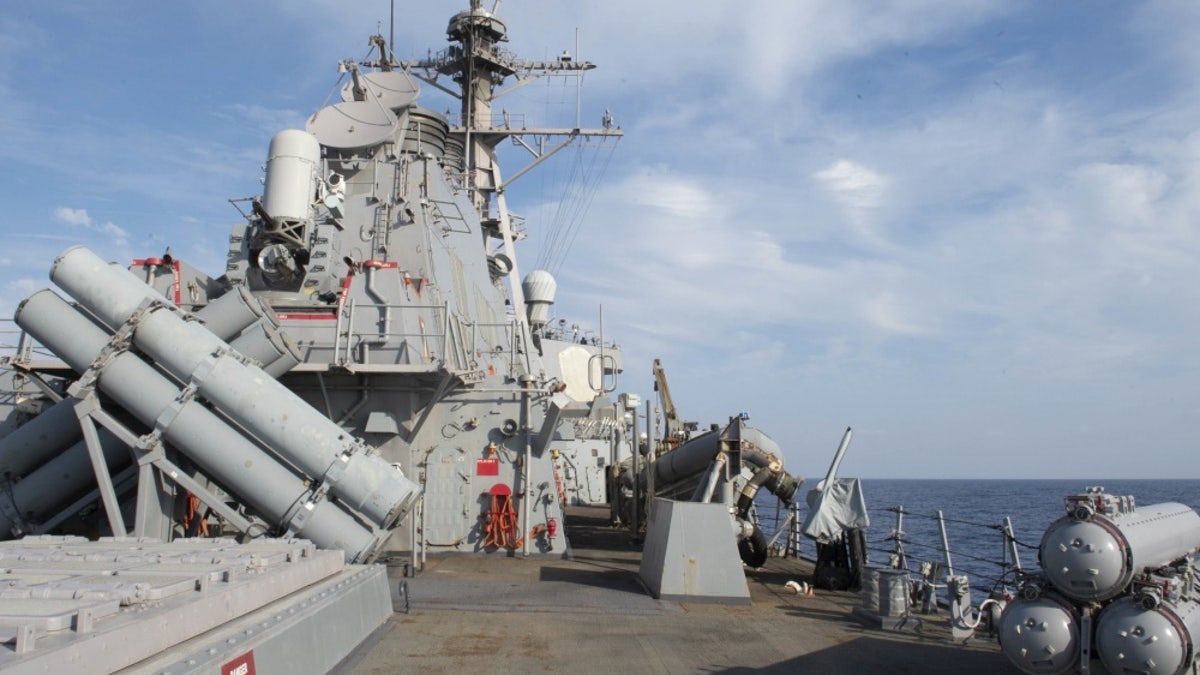Fox News Flash top headlines for January 17
Fox News Flash top headlines are here. Check out what's clicking on FoxNews.com.
Navy destroyers will soon be armed with high-powered, precision 60kw laser weapons that can track and incinerate attacking drone targets at sea, bringing new "at-the-speed-of-light" attack technology to maritime warfare in new ways.
Lasers have been operational for years, as the Navy’s Laser Weapons System (LAWs) was deployed on the USS Ponce several years ago. However, the service has for many years been working with industry partners to further refine, sharpen, strengthen, and power-scale newer laser-weapon applications. One of them, called High Energy Laser with Integrated Optical-dazzler and Surveillance (HELIOS), will soon be arming U.S. Navy Arleigh Burke-class DDG 51 Flight IIA destroyers.
Rear Adm. Boxall, the Navy’s former director of surface warfare, previously indicated that the HELIOS would go on the USS Preble, a move which the Navy expects to happen later this year. The speed and technical advances of Navy laser systems were highlighted in a recent Chief of Naval Operations CNO NAVPLAN strategy document, in which CNO (Chief of Naval Operations) Adm. Michael Gilday writes that the service is on pace to deploy new, highly capable lasers ahead of rival nations.
"We will complete fielding of the high-power directed energy weapons systems our fleet needs to prevail in a near-peer fight before our adversaries achieve the same capability," the CNO NAVPLAN states.
NAVY ELECTRONIC WARFARE STOPS MULTIPLE ENEMY MISSILE ATTACKS AT ONCE
The Lockheed-built weapon is now operational and has been delivered to the Navy, following years of development. HELIOS is slated to be integrated on destroyers later this year, following a series of ongoing testing at Wallops Island, Va.

The Arleigh Burke-class guided-missile destroyer USS Arleigh Burke (DDG 51) transits the Mediterranean Sea Oct. 7, 2018 - file photo. (U.S. Navy photo by Mass Communication Specialist 2nd Class Justin Yarborough/Released)
The testing, HELIOS weapons developers explain, will begin on land-based sites and move to sea-based tests where the laser is fired against drones from a destroyer at sea.
"We will be testing the accuracy and the ability of a laser to take out smaller targets, proving out a lot of work we have done in the lab," Jon Rambeau, vice president and general manager, Lockheed Martin Rotary and Mission Systems and Integrated Warfare Systems and Sensors, told Warrior in an interview.
HELIOS is a 60kw laser system, engineered with multiple kilowatt fibers to reach new levels of precision, surveillance, beam quality and strength or power levels. Lockheed Martin completed the Critical Design Review and Navy Factory Qualification Test milestones in 2020.
NAVY ARMS SEA DRONES FOR OCEAN ATTACK
"HELIOS is designed to be compatible with the ships and integrate seamlessly into ships, cooling systems and power systems. There is operational hardware that integrates into the ship hardware," Rambeau said.
Refining, testing and improving maritime laser technology has been a long-standing Navy developmental effort, which has sought to balance the requisite heat, cooling and expeditionary electrical power requirements needed to support laser weapons operations. Lockheed information on the weapon cites that HELIOS is built with "Thermal & Environmental Management Subsystems, Refrigerant Cooling, Ship’s Chilled Water & Clean Dry Air Distribution" as well as a "Spectral Beam Combined Fiber Laser."
HELIOS will also be integrated with Navy ship AEGIS Combat Systems that draw upon common technical standards to synergize fire control, ballistic missile defense and emerging weapons such as lasers.
CLICK HERE TO GET THE FOX NEWS APP
"This is an ability for us to validate technology, so that we can continue to design similar capabilities in the future," Rambeau added.
-- Kris Osborn is the Managing Editor of Warrior Maven and The Defense Editor of The National Interest --





















